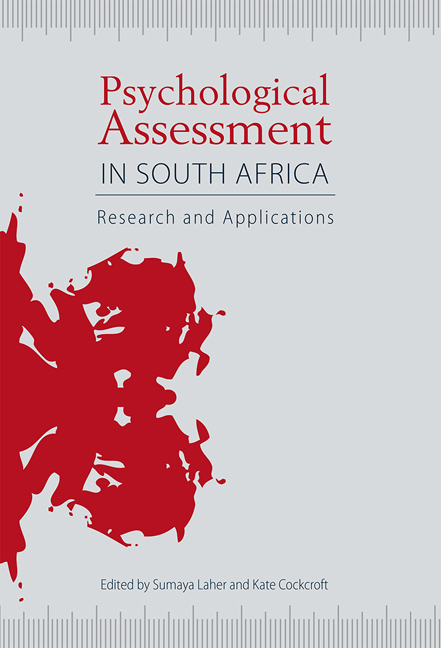Book contents
- Frontmatter
- Contents
- Tables and figures
- Acknowledgements
- Acronyms and abbreviations
- 1 Contextualising psychological assessment in South Africa
- Section One Cognitive tests: conceptual and practical applications
- Section Two Personality and projective tests: conceptual and practical applications
- 14 The Sixteen Personality Factor Questionnaire in South Africa
- 15 Using the Fifteen Factor Questionnaire Plus in South Africa
- 16 The Basic Traits Inventory
- 17 The Myers-Briggs Type Indicator® in South Africa
- 18 The NEO-PI-R in South Africa
- 19 Using the Occupational Personality Profile in South Africa
- 20 The Occupational Personality Questionnaire
- 21 The Millon Inventories in South Africa
- 22 Assessment and monitoring of symptoms in the treatment of psychological problems
- 23 Assessment in routine clinical and counselling settings
- 24 Projective assessment of adults and children in South Africa
- 25 The use of the Children's Apperception Test and Thematic Apperception Test in South Africa
- 26 Projective assessment using the Draw-A-Person Test and Kinetic Family Drawing in South Africa
- 27 The Rorschach in South Africa
- Section Three Assessment approaches and methodologies
- Contributors
- Index
18 - The NEO-PI-R in South Africa
from Section Two - Personality and projective tests: conceptual and practical applications
Published online by Cambridge University Press: 21 April 2018
- Frontmatter
- Contents
- Tables and figures
- Acknowledgements
- Acronyms and abbreviations
- 1 Contextualising psychological assessment in South Africa
- Section One Cognitive tests: conceptual and practical applications
- Section Two Personality and projective tests: conceptual and practical applications
- 14 The Sixteen Personality Factor Questionnaire in South Africa
- 15 Using the Fifteen Factor Questionnaire Plus in South Africa
- 16 The Basic Traits Inventory
- 17 The Myers-Briggs Type Indicator® in South Africa
- 18 The NEO-PI-R in South Africa
- 19 Using the Occupational Personality Profile in South Africa
- 20 The Occupational Personality Questionnaire
- 21 The Millon Inventories in South Africa
- 22 Assessment and monitoring of symptoms in the treatment of psychological problems
- 23 Assessment in routine clinical and counselling settings
- 24 Projective assessment of adults and children in South Africa
- 25 The use of the Children's Apperception Test and Thematic Apperception Test in South Africa
- 26 Projective assessment using the Draw-A-Person Test and Kinetic Family Drawing in South Africa
- 27 The Rorschach in South Africa
- Section Three Assessment approaches and methodologies
- Contributors
- Index
Summary
The first edition of the Neuroticism–Extraversion–Openness Inventory (NEO-I) was published in 1978. The NEO-I consisted of 3 domain scales (Neuroticism, Extraversion and Openness to Experience) and 18 facet scales. In 1983, 18 item domain scales measuring Agreeableness and Conscientiousness were added, and around 1985 a revised version was produced, the NEO Personality Inventory (NEO-PI). The next revision occurred in the late 1980s and was published in 1990 as the Revised NEO Personality Inventory (NEO-PI-R). In 1990, the facet scales for Agreeableness and Conscientiousness were completed and 10 items in the original NEO were modified. The 30 facet scales of the NEO-PI-R were chosen to represent constructs frequently identified in the psychological literature that embody important distinctions in each of the 5 domains (Costa & McCrae, 1992). At this time another instrument was created, the NEO Five-Factor Inventory (NEO-FFI). Most recently the NEO-Personality Inventory-ÿ3 (NEO-PI-3) has been released.
The NEO-PI-R is based on the idea that personality traits are arranged in hierarchies from very broad to very narrow, and that both highly general (domain) and relatively specific (facet) traits should be assessed. The constructs measured by the NEO-PI-R are not original discoveries and were not intended as such. Rather, the developers searched the available psychological literature to identify traits and dispositions that were important to personality theorists, that were represented as trait terms in the natural English language and that appeared in personality research literature. Items were then developed to tap those constructs. Costa and McCrae (1992) employed a modified rational approach to scale construction. Although item analyses began with a pool of items constructed rationally, final item selection was based on extensive item analyses using factor analytic techniques.
The NEO-PI-R
The NEO-PI-R is a self-report instrument consisting of 240 items and requiring approximately 45 minutes to complete. It is available in two forms: Form S, which is an instrument for self-rating, and Form R, which is used for rating someone else.
- Type
- Chapter
- Information
- Psychological Assessment in South AfricaResearch and Applications, pp. 257 - 269Publisher: Wits University PressPrint publication year: 2013



